Life Management
Copyright (c) 2004 by Heidrun Beer - all rights reserved
This
article is based on the assumption that each and every situation in life can be
found on a scale of conditions. Each step on this scale correlates with a
certain set of key actions. These key actions, if applied, will move the
situation one step up on the scale, while the law of
entropy will bring the situation
down another step if the key actions are not applied for any prolonged amount of
time.
All aspects of life follow
a natural pattern of birth, growth, maturity, decay and death. In nature, this
is an instinctive cycle, working without any conscious control. Their genetic
programming, the sunlight, the seasons - all these exterior factors interact to
form an individual plant's or animal's life cycle.
The human being with his
conscious component is the only one who has the potential to influence these
natural patterns and make changes to them according to his wishes. If - and only
if! - he or she is aware of this possibility and trained in the art of steering!
A majority of people never
take the rudder of their lives into their own hands. They start out being
steered by parents, then they are steered by priests and teachers, then they
spend some decades being steered by bosses, goverment officials, husbands or
wives, and finally their children take over and keep steering them until they
die.
With a minimum of training,
you can be your own captain! Actually the instructions on these pages are all you
need as a foundation to build on. If you want to skip the theory (which is not
such a good idea), you can find the collection of life management patterns
here.
Natural curve
 The
natural life pattern is a simple curve, starting at the bottom, reaching a peak
- where it remains for a shorter or longer while -, then declining and arriving
at
the bottom again. Our bodies are part of nature, so they have to follow this
curve to a greater or lesser degree (although with modern medicine, we do have an
influence which can modulate the natural trend).
The
natural life pattern is a simple curve, starting at the bottom, reaching a peak
- where it remains for a shorter or longer while -, then declining and arriving
at
the bottom again. Our bodies are part of nature, so they have to follow this
curve to a greater or lesser degree (although with modern medicine, we do have an
influence which can modulate the natural trend).
Our activities, though, are
at least partially expressions of the law-making spirit,
and therefore don't necessarily follow this automatic pattern. They have their
own set of principles. As soon as we know these principles, we can react to
everything which happens and make our visualizations come true, even if we meet
difficulties, opposition or resistance.
And most important: we can
recognize the downtrend of an activity - and with intelligent application
of our knowledge of the life management patterns, we can reverse the trend and
make it a successful activity again!
In some areas of life this
may not seem a very worthwile thing to do - but where our marriage is involved,
our children, our professional career or our own business, the knowledge of the
life management patterns can make the difference between total failure and
screaming success, even the difference between life and death!
Construction
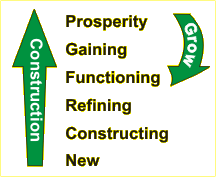 To the right, we see the scale of management
patterns which we need to follow if we want any activity to be successful. Each
level of the scale has its own set of vital steps which, if applied, will bring
the activity to the next higher level. If not applied, the activity will follow
the law of entropy and either quickly or
gradually sink down to the next lower level.
To the right, we see the scale of management
patterns which we need to follow if we want any activity to be successful. Each
level of the scale has its own set of vital steps which, if applied, will bring
the activity to the next higher level. If not applied, the activity will follow
the law of entropy and either quickly or
gradually sink down to the next lower level.
This scale can be seen in
an individual human's life as well as in the history of a company, a culture, or
even a whole species.
It is not always a straight
path. In a single human's life maybe - we go from a poor youngster to a rich old
man -, but a simple family model shows us already how such a curve can go in
circles.
Loops
We have a couple of lovers
who get married (new activity). They have studied the life management patterns
well and apply each of them as it becomes necessary.
First, they build their
nest ("constructing"). Then they have a few years of growing together into a
good team ("refining"). They spend some time to re-study of the life management
patterns in regular intervals and optimize every little detail of their
organization this way.
Now they are functioning
really well - a husband who takes care of the income and a wife who takes care
of the house. They work hard ("gaining") and save enough money to become wealthy
enough to be able to afford a few children ("prosperity").
Here we see a change in
things. The same income now supports more people than before. They need a bigger
house, maybe with a garden, a bigger car, more food, more clothes, education,
medical care, you name it. The family is no longer wealthy. Their income is
still good, but at the end of the month it is used up. They have expanded - but
funnily enough, on the scale of life management patterns this has brought them
down instead of up!
 Their
scene is bigger than before, but they have stepped down from "prosperity" to mere
"functioning". Daddy needs to do something now. He must get a promotion in his
company. A few years later, Mummy might be able to get a job too. Now the family
can begin to earn more than they spend. They climb up the scale of life
management patterns again. They did not go up on a straight line like the rich
old bachelor - they went up in a loop which first took them all the way up to
"prosperity", then back down to "functioning" (now with more people - they
have grown),
and finally up to "prosperity" a second time.
Their
scene is bigger than before, but they have stepped down from "prosperity" to mere
"functioning". Daddy needs to do something now. He must get a promotion in his
company. A few years later, Mummy might be able to get a job too. Now the family
can begin to earn more than they spend. They climb up the scale of life
management patterns again. They did not go up on a straight line like the rich
old bachelor - they went up in a loop which first took them all the way up to
"prosperity", then back down to "functioning" (now with more people - they
have grown),
and finally up to "prosperity" a second time.
Multiple loops
The bigger the scene to
which we apply a life management scale, the more likely will it go up in
multiple loops instead of straight lines. This is simply due to the fact that
any bigger scene is composed of smaller scenes, each of which has its own
individual position on its own individual life management scale, and will have
times where it is low on the scale - so that the overall whole must lower its
position too in order give it the resources necessary to move it up the scale.
Let's take the career of a
poor farmer who went to America in the early 20th century. He started as a
dishwasher, became a manager in the same company and worked himself up to a
modest personal wealth.
 As
an individual, he already reached the top of the life management scale - but now
he starts to expand. He founds his first company, which immediately brings him
all the way back to the bottom of the scale. He is now at "New" again. He had
enough money to make his life comfortable and still save some, but for a young
company that's nothing - the money just evaporates. Although he has expanded, he
needs to apply the same series of life management patterns again which brought
him up the scale when he first stepped down from the ship: he needs to start at
"new" and go through the steps of "construction", "refinement" etc. again, until
he finally arrives at the top of the scale for the second time.
As
an individual, he already reached the top of the life management scale - but now
he starts to expand. He founds his first company, which immediately brings him
all the way back to the bottom of the scale. He is now at "New" again. He had
enough money to make his life comfortable and still save some, but for a young
company that's nothing - the money just evaporates. Although he has expanded, he
needs to apply the same series of life management patterns again which brought
him up the scale when he first stepped down from the ship: he needs to start at
"new" and go through the steps of "construction", "refinement" etc. again, until
he finally arrives at the top of the scale for the second time.
Now he is not only a
wealthy man, he has also a wealthy company. He went full circle through the
first loop. He knows now how it is done. He takes another step of expansion and
opens a second branch in the next bigger town. Here we go again: through "new",
"construction", "refinement" etc., until the second branch is a wealthy business
too. At the end of his life, he is the king of a business empire like Microsoft
or McDonalds - and all he did was to work the life management scale up and down
in multiple loops.
Destruction
 Unfortunately, life is not
always nice, and we all are used to seeing not only construction but also
destruction. There are several reasons for this, which we will examine
later.
For now we need to know one thing: There is also a reversed life management
scale, which mirrors a scene that is spiraling downward instead of upward.
Unfortunately, life is not
always nice, and we all are used to seeing not only construction but also
destruction. There are several reasons for this, which we will examine
later.
For now we need to know one thing: There is also a reversed life management
scale, which mirrors a scene that is spiraling downward instead of upward.
If it starts to act in a
rather small scene, it might go straight to the bottom - as in a man losing
first his job and then his family, then becoming homeless, and dying from
pneumonia under a bridge a few months later, as he was not used to the rough
circumstances of life under a bridge in the middle of winter.
 If
the scene starts a little bigger, we might see a similar loop or multiple loop
as in construction, just a loop going down instead of up. Say, we have a rich
young man who inherited money but has poor business skills. He first lives in a
villa but cannot support all the staff that are needed to keep it in good shape.
So he fires the staff, sells the villa and buys an apartment instead.
If
the scene starts a little bigger, we might see a similar loop or multiple loop
as in construction, just a loop going down instead of up. Say, we have a rich
young man who inherited money but has poor business skills. He first lives in a
villa but cannot support all the staff that are needed to keep it in good shape.
So he fires the staff, sells the villa and buys an apartment instead.
He has now completed the
first downward loop: realizing that he is losing money, he has done at least one
intelligent thing. He has made his scene so much smaller, that with the existing
money he is still - or again - wealthy. If he now has also the intelligence to
study and apply the correct life management pattern, he has a chance to remain
wealthy on the new, smaller level - or at least to go not farther down than to a
level of functioning.
A big business - or a
country - will go through several loops of making the scene smaller before it goes bankrupt. It can close
branches, it can sell houses and other property, it can fire people and so
reduce cost. Each of these steps makes its scene smaller, but this contraction
can be healthy, if there is enough substance left to keep the production going.
Sometimes there is no other way to stabilize a scene - it is certainly better to
do a controlled contraction than to remain big until the money is used up and
then crash with a big bang.
Parallel scales - trend reversal
What is fascinating about
the whole matter, and what most people don't know, is that the two life
management scales - the scale of construction and the scale of destruction - are
running a parallel course, and that it is possible to jump from a destruction
spiral into a construction spiral, if we apply the life management pattern of
the parallel step in the construction scale (plus a few extras).
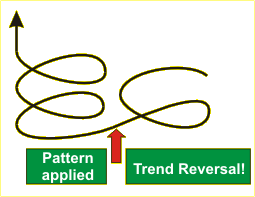
This is the curve showing a
trend reversal. It can be done on any of the steps of the life management scale
of destruction. If, for instance, the young man with the villa realizes early
that he is losing money, he doesn't necessarily have to sell his family villa.
He can also jump to the parallel step in the construction scale - which would be
"gaining" -, and stay a wealthy man.
More probably, he would
have to go down to "functioning". If, as a typical rich man's spoiled son, he
didn't do any training earlier in his life, he might need to go all the way down
the construction scale to "new" and "constructing" in order to learn what he
needs to manage his property and keep it, instead of losing it.
Again we emphasize that the
life management patterns can be applied to activities of any size. A culture
that finds itself in a critical condition can decide to jump into the
"construction" step - plus a few necessary additions -, reverse the trend, go
through "refining" and end up at "functioning" again. An individual who was
functioning for a while but now finds himself suffering, can jump into the
"refining" step of the construction scale, again plus a few necessary additions,
reverse the trend and move all the way up to "prosperity".
Without such an effort, the
law of entropy will bring the individual or
activity all the way down to a breakdown, the equivalent of death. This, too, is
a natural thing to happen. It cleans up the scene by removing people and
activities which are not healthy enough to manage the steady effort of
surviving.
Here are the two scales
again, now side by side, to make their parallel steps visible:
Scenes and actors
Life is complicated; in
order to get a system into it, we must show its structure in a way which is as
simple as possible.
| Let's make a first
distinction between a scene and an actor. A family with its house, garden,
furniture and people would be a
scene; father, mother and baby would be the actors.
Now on the next higher level
of nesting, the scene could be a town, and
families - as well as individuals - would be actors. On the next higher level of
nesting, a culture would be a scene, and towns, families and individuals would
be actors. On a global scene, at the moment the biggest we have, the nations
would be the actors, together with some VIP individuals.
To make it really, really
simple, we divide the actors in two groups: heroes and villains. Heroes are
good, villains are bad. Or to fit into our system of construction and
destruction, heroes are constructive and villains are destructive. Certainly
each of us will be able to think of a hero and a villain in his life, or a hero
country and a villain country on a global scene... |
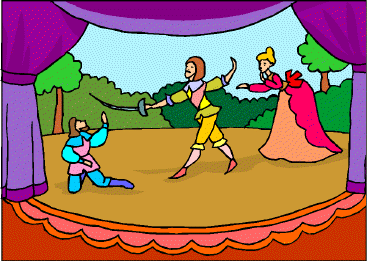
A scene: an environment
with its actors |

 Closer to the truth would
probably be a group of positive heroes (good people), a group of villains (bad people), and a
third group of tragic heroes (good people with
problems).
Closer to the truth would
probably be a group of positive heroes (good people), a group of villains (bad people), and a
third group of tragic heroes (good people with
problems).
Spiritually, there is of
course much more to say about this and there are no really bad people. However,
for the purpose of the quick and efficient management of a scene, we use this
simplification, always keeping in mind that it is for practical purposes only
and we don't really think bad about our "villains".
On the scale of life
management patterns, scenes go from "New" up to "Prosperity", or from
"Prosperity" down to "Breakdown". Scenes don't have a negative scale
(unless they are an actor on the next higher level of nesting). This is not
so for actors: if actors are villains , their scale of life
management patterns expands below zero to comprise several negative steps.
Construction is caused by
heroes (good people). Destruction is caused by villains (bad people) and
tragic heroes (good people with problems). Depending on the ratio of heroes to
villains and tragic heroes we have a scene of prosperity, a scene of mere
functioning, a critical scene, or even the breakdown of a scene.

Villains are probably
beyond hope, but tragic heroes (good people with problems) can benefit
enormously from the personal scale of life management patterns. Again the rule
is that applying one pattern will bring us up to the next level, while not
applying it will give us into the hands of the law of
entropy, and we will sink or fall to the
next lower level.
Doing a therapy will always
be an option for people with problems too. Another option is a good program of
mental training, combined with the application of life management patterns. The
life management patterns work without delay or waiting times. They are an
instant solution, while therapy and mental training both can take months, if not
years.
Personal life management scales
 To
the left, we have the life management scale of a hero (good person). The main principle is
contribution to his scene or scenes.
To
the left, we have the life management scale of a hero (good person). The main principle is
contribution to his scene or scenes.
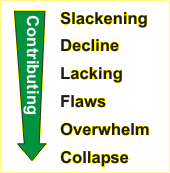 If
the person has experienced abuse or trauma in the past, or if the current
environment is not taking care of his needs (the environment acts as a villain), a hero can turn into a tragic hero (good person with
problems).
If
the person has experienced abuse or trauma in the past, or if the current
environment is not taking care of his needs (the environment acts as a villain), a hero can turn into a tragic hero (good person with
problems).
Most probably he will tend
to stay in the middle of the scale, but theoretically a destructive influence can bring
him all the way down on a reversed life management scale, which corresponds to
the scale to the left like the destruction scale above corresponds to the
construction scale.
In other words: a person
who finds himself at "overwhelm" can jump into the positive scale and become a
"trainee" again in order to learn what brings him down and how to escape this
trap. Or if he finds himself goofing up, he can jump into the life management
pattern of "apprentice", practice some more, and work himself up the positive
scale to a level of perfection again.
The sub-zero scale
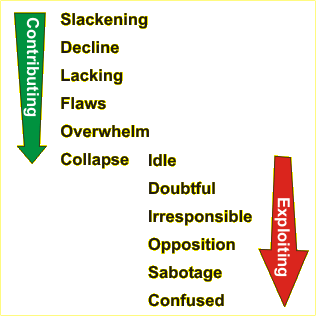 Only
in rare cases will tragic events destroy a person so much that he goes
all the way down the sub-zero scale (see image to the right). This is
traditionally the scale of the villains (the bad people). But it can happen,
if the circumstances are grim and there is no help in sight. Instead of working
himself back up the positive scale, a person can start behaving in an
irresponsible way, or fighting his own team, or sabotaging them.
Only
in rare cases will tragic events destroy a person so much that he goes
all the way down the sub-zero scale (see image to the right). This is
traditionally the scale of the villains (the bad people). But it can happen,
if the circumstances are grim and there is no help in sight. Instead of working
himself back up the positive scale, a person can start behaving in an
irresponsible way, or fighting his own team, or sabotaging them.
The end of the way is a
situation of total confusion. Here the person is no danger anymore. He is too
beaten to fight or sabotage anything or anybody. For the same reason, he needs a
maximum of support.
The life management
patterns on the sub-zero scale do not have
parallels in the upgoing scale. They have their own formulas which, applied,
will bring them one step higher, but still on the sub-zero scale.
Only at the zero line -
where they are idle, or in other words, do neither damage a scene nor contribute
to it -, will such people have a chance to jump over into the upgoing scale.
They will have to make an entirely new entry into the scene.
Contribution versus exploitation
If we look at the relations
between the actor and the scene (the immediate environment), we see that the
actor's patterns above zero are contributing patterns, while the actor's
patterns below zero are exploiting patterns. In other words, below zero the
tragic hero or villain needs more contribution from other people than he can
give to them.
A family, group, company,
community, culture, nation or biosphere can support a certain percentage of such
people, but if the majority of its members are not heroes (contributing people),
it will go down on the destruction scale until it no longer exists.
The key to a scene moving
upwards on the construction scale is a majority of contributing people
("heroes"). The key to a scene moving
downwards on the destruction scale is the influence of exploiting people
("villains" and "tragic heroes"). They don't necessarily
have to be a majority - they can produce so much chaos that one or two of them
can be enough to wreck a scene.
Not exploiting the system
are of course most children and most people of old age. Children can usually be
found on the uptrend scale as "trainees". And most people of old age have been
contributing in the past, supported children before they were old enough to
contribute, and now only take out of the system a percentage of what they have
put into it in their active years.
Where only one person is
active in a scene, the life management patterns of
the scene and the actor are directly related. This can be seen in a company,
where one worker (actor) equals one post (scene).
 |
 |
A car
mechanic who is excellent in his job will have his post in a condition of
prosperity. If all his colleagues are excellent too - including the
management staff and even the boss -, they will have a company in a
condition of prosperity. At the moment where there is only one whose work is
flawed, the company will go down into the direction of mere functioning.
If the company is
bigger and there are more nested scenes,
whole rows of departments and sections - where people are excellent - will be found
to be in a state of prosperity, while the one which has a goofing worker
will merely function (or maybe less than that) |
The scenes of an individual
The principle of
nesting is especially important where we look
at the scene not of a group but of an individual. Instinctively, we will tend to
make the equation of 1 individual = 1 scene.
This is not so! Every
individual has a whole collection of scenes, and it depends on his
awareness horizon (where he has focussed his
attention) whether each of these scenes is in an equally good condition.
The same individual who has
his business activity in prosperity, can have a less than optimum scene in other areas of his
life. A manager who devotes all of his energy to keeping his company running,
may have a family suffering from his absence, and a body in critical condition
because he doesn't pay attention to his diet or exercises. Each of these
scenes needs to be addressed with the proper life management pattern in order to
improve. To apply the pride resulting from one (very well running) scene to
another, much more desolate scene can be a dangerous mistake.
Managing a scene
The manager who is
responsible for a scene will be successful if he does the following in regular
intervals (companies do it once at the end of every week):
-
establish the condition of the entire scene and
work out the tasks which need to be done by each of the actors in order to
apply the matching life management pattern
-
establish the condition of each of the scene's
actors with regard to the scene (including himself) and get them all to apply the matching life
management pattern
This seems nearly too simple, but in actual life,
some of these patterns can require quite some time! If we consider the time it
needs to build a house - that would be one step, "constructing", in only one
scene. To get a badly neglected body back into shape is also a project which can
need a year or longer.
The life management patterns are the answer to Isaac
Asimov's "last question". Generations after generations of computer operators
asked their computers how to reverse the
entropy of the universe. Well, at
least for the universe of a human life the answer is: find out where your scene
is on the life management scale and apply the matching pattern!
Now let's have a look at the very formulas of the
life management patterns themselves.
 The
natural life pattern is a simple curve, starting at the bottom, reaching a peak
- where it remains for a shorter or longer while -, then declining and arriving
at
the bottom again. Our bodies are part of nature, so they have to follow this
curve to a greater or lesser degree (although with modern medicine, we do have an
influence which can modulate the natural trend).
The
natural life pattern is a simple curve, starting at the bottom, reaching a peak
- where it remains for a shorter or longer while -, then declining and arriving
at
the bottom again. Our bodies are part of nature, so they have to follow this
curve to a greater or lesser degree (although with modern medicine, we do have an
influence which can modulate the natural trend).
 Their
scene is bigger than before, but they have stepped down from "prosperity" to mere
"functioning". Daddy needs to do something now. He must get a promotion in his
company. A few years later, Mummy might be able to get a job too. Now the family
can begin to earn more than they spend. They climb up the scale of life
management patterns again. They did not go up on a straight line like the rich
old bachelor - they went up in a loop which first took them all the way up to
"prosperity", then back down to "functioning" (now with more people - they
have grown),
and finally up to "prosperity" a second time.
Their
scene is bigger than before, but they have stepped down from "prosperity" to mere
"functioning". Daddy needs to do something now. He must get a promotion in his
company. A few years later, Mummy might be able to get a job too. Now the family
can begin to earn more than they spend. They climb up the scale of life
management patterns again. They did not go up on a straight line like the rich
old bachelor - they went up in a loop which first took them all the way up to
"prosperity", then back down to "functioning" (now with more people - they
have grown),
and finally up to "prosperity" a second time. As
an individual, he already reached the top of the life management scale - but now
he starts to expand. He founds his first company, which immediately brings him
all the way back to the bottom of the scale. He is now at "New" again. He had
enough money to make his life comfortable and still save some, but for a young
company that's nothing - the money just evaporates. Although he has expanded, he
needs to apply the same series of life management patterns again which brought
him up the scale when he first stepped down from the ship: he needs to start at
"new" and go through the steps of "construction", "refinement" etc. again, until
he finally arrives at the top of the scale for the second time.
As
an individual, he already reached the top of the life management scale - but now
he starts to expand. He founds his first company, which immediately brings him
all the way back to the bottom of the scale. He is now at "New" again. He had
enough money to make his life comfortable and still save some, but for a young
company that's nothing - the money just evaporates. Although he has expanded, he
needs to apply the same series of life management patterns again which brought
him up the scale when he first stepped down from the ship: he needs to start at
"new" and go through the steps of "construction", "refinement" etc. again, until
he finally arrives at the top of the scale for the second time.
 If
the scene starts a little bigger, we might see a similar loop or multiple loop
as in construction, just a loop going down instead of up. Say, we have a rich
young man who inherited money but has poor business skills. He first lives in a
villa but cannot support all the staff that are needed to keep it in good shape.
So he fires the staff, sells the villa and buys an apartment instead.
If
the scene starts a little bigger, we might see a similar loop or multiple loop
as in construction, just a loop going down instead of up. Say, we have a rich
young man who inherited money but has poor business skills. He first lives in a
villa but cannot support all the staff that are needed to keep it in good shape.
So he fires the staff, sells the villa and buys an apartment instead.


 Closer to the truth would
probably be a group of positive heroes (good people), a group of villains (bad people), and a
third group of tragic heroes (good people with
problems).
Closer to the truth would
probably be a group of positive heroes (good people), a group of villains (bad people), and a
third group of tragic heroes (good people with
problems). 
 To
the left, we have the life management scale of a hero (good person). The main principle is
contribution to his scene or scenes.
To
the left, we have the life management scale of a hero (good person). The main principle is
contribution to his scene or scenes.  If
the person has experienced abuse or trauma in the past, or if the current
environment is not taking care of his needs (the environment acts as a villain), a hero can turn into a tragic hero (good person with
problems).
If
the person has experienced abuse or trauma in the past, or if the current
environment is not taking care of his needs (the environment acts as a villain), a hero can turn into a tragic hero (good person with
problems).  Only
in rare cases will tragic events destroy a person so much that he goes
all the way down the sub-zero scale (see image to the right). This is
traditionally the scale of the villains (the bad people). But it can happen,
if the circumstances are grim and there is no help in sight. Instead of working
himself back up the positive scale, a person can start behaving in an
irresponsible way, or fighting his own team, or sabotaging them.
Only
in rare cases will tragic events destroy a person so much that he goes
all the way down the sub-zero scale (see image to the right). This is
traditionally the scale of the villains (the bad people). But it can happen,
if the circumstances are grim and there is no help in sight. Instead of working
himself back up the positive scale, a person can start behaving in an
irresponsible way, or fighting his own team, or sabotaging them.